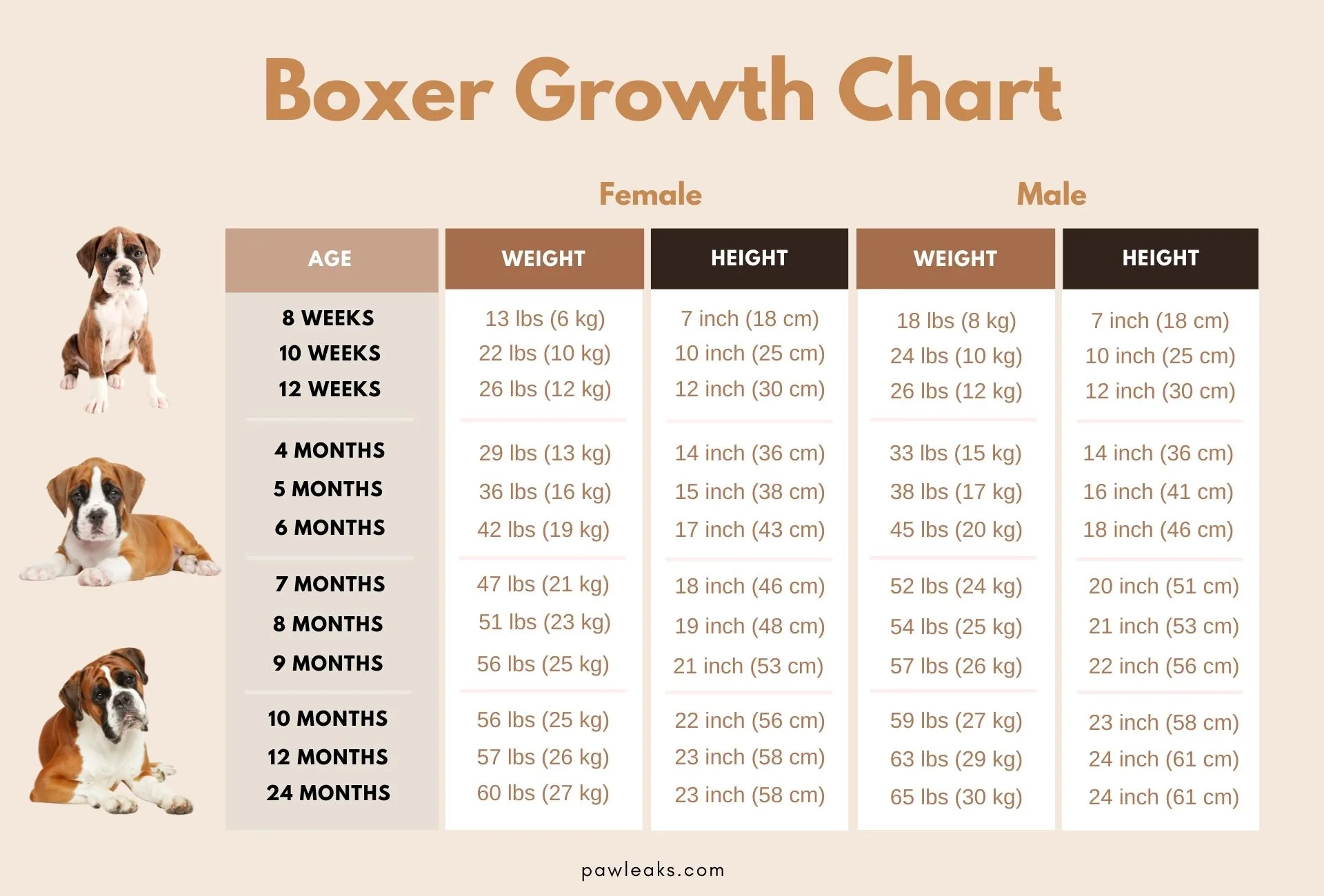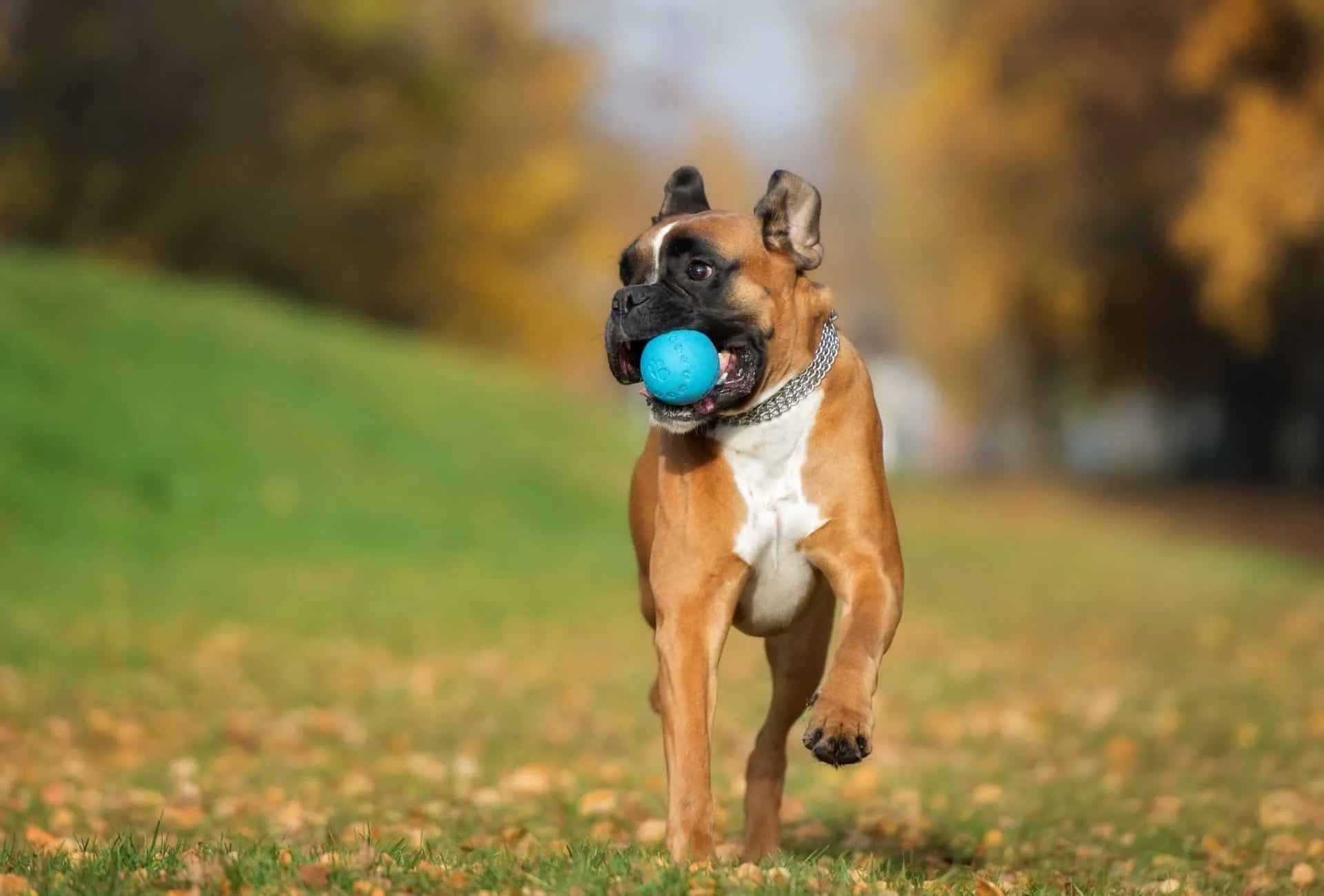Courage and loyalty are attributes the Boxer is usually described with.
With a good work ethic, playful demeanor, and a goofy face, this dog breed ranks among the top 10 in the USA for a while now.
Their nobility and elegance came to focus after the originally working breed Boxer became unemployed during the early 19th century.
The AKC registered the first Boxer dog in 1905, but the real popularity started with the national celebrity Boxer named Bang Away.
The breed name derives from the way they defend themselves with their paws while playing.
It really appears as the dog spars with the front paws.
There is no doubt one might be tempted to get bring home one of these loving fellas.
The growth in dogs has much to say about their health and potential – but how?
While growing up dogs that suffer from some diseases might stagnate more than others.
Boxers are a medium to large dog breed and are pretty safe from the usual bone and muscle disorders in larger dogs.
However, hip dysplasia remains one of the most common issues.
Health testing from the breeder guaranteeing your puppy’s parents are dysplasia-free is recommended if you plan on getting a Boxer.
Meeting your dog’s mother and father can give you a general idea of what to expect from your puppy in terms of physique.
Don’t be shy about asking questions about their character too.
Reputable breeders will let you meet the parents and give you contacts from owners of puppies born in previous litters.
Call those people and ask them how satisfied they are with their Boxer’s health & appearance and whether their expectations have been met.
Boxer Puppy Growth Chart
A puppy growth chart is only an estimation of the dog’s weight and height during different chronological growth stages.
Most Boxer puppies will correspond just fine to the ranges mentioned for their age.
If that’s not the case, instead of taking measures on your own, make a veterinary appointment to discuss any of the concerns you might have regarding your dog’s growth.

It is super important to not rush the growing process.
Dogs that are overweight can experience problems later on in life that might have been avoided by maintaining an appropriate body condition.
Comparing the dog’s weight and height with the growth chart I have presented might leave you in a situation where your puppy ranks below the average.
If that’s the case don’t start with overfeeding the animal or use shady supplements.
Moreover, the veterinarian can have the pup checked for possible health conditions causing the slow growth.

Even with late bloomers, there is no reason to worry.
Some dogs experience growing episodes sooner than others.
That doesn’t mean that all of them aren’t going to become as large as one might expect.
The same rules apply to puppies that grow too fast.
Cutting off food can seriously harm the dog’s well-being and cause metabolic and other disorders.
Damage due to wrong feeding can be avoided by using high-quality premium food and sticking to the recommendations according to weight and age on the labels.
Never miss out on consulting your vet on the topic first – they will be glad to guide you through it!
Boxer Growth Stages
Until they reach adulthood, Boxers go through 3 growth stages.
The general difference between the growth stages is how fast the puppy grows during the period and how they appear in posture and body condition.
The first stage is from birth until they are 2 weeks of age.
Even though it’s a short period, most puppies manage to double their weight – it’s pretty rapid growth.
The mother’s milk they consume during this period stimulates brain development and physical development significantly.
After the second week, the growth rate slows down.
Boxer puppies increase their weight by approximately 300% between 3 and 12 weeks of age and keep their round shape.
Most breeders wean the puppies off around the 4th-5th week.
The mother’s food is replaced with solid food and that affects the weight gain.
Once your Boxer puppy is 4 months of age he/she is expected to double the weight in the next 6-12 months.
After the first year, the height significantly increases and it’s possible for your dog to look skinny.
At 18 months of age, you can probably introduce your companion as a fully developed, curious, and independent adult Boxer.
If your Boxer is already fully grown it doesn’t mean you should stop weighing them.
Regular monitoring for sudden changes helps with evaluating whether or not there’s a health issue.
How Much Should a Boxer Puppy Weigh?
Boxer puppies have somewhere between 2.5 and 3.2 lbs (1.2 and 1.4 kg) at birth. At the end of the first stage, they can reach around 4.5 lbs (2 kg).
At 1 month of age, their stuffed muscle figure comes at about 5.5-9 lbs (2.5-4.1 kg) for male puppies and 4.5-8 lbs (2-3.6 kg) for females.
By the time they are 16 weeks old, males weigh 30-35 lbs (13.6-15.9 kg) and females 28-30 lbs (12.7-13.6 kg).
Male Boxers are expected to have approximately 52-61 lbs (23.6-27.7 kg) on their first birthday; for female 1-year-old Boxers, the range is 52-59 lbs (23.6-26.8 kg).
In the next six months, the growth slows down to about 2-3 lbs (0.9-1.4 kg) of additional bodyweight in half a year.
How Much Should a Boxer Weigh at 6 Months?
Male Boxers should weigh around 41-48 lbs (19-22 kg) by the time they reach 6 months of age.
Female boxer puppies are expected to have 39-44 lbs (18-20 kg) when they are half a year old.
All puppies have already reached approximately 75% of their full height at this age.
6 months old male Boxers should be around 17 and 19 inches (43-48 cm) tall and female Boxers are approximately an inch shorter than the males.
How Long Does It Take For a Boxer to Be Fully Grown?
Since the Boxer qualifies as a medium to large breed, it takes longer for them to reach their full-sized version compared to other smaller breeds.
It’s a general rule that Boxers are already fully grown at 18 months of age; however, the process can take even longer.
There are exceptions when Boxers complete the growth at 20, even 24 months.
Female Boxers that are done growing up weigh approximately 55-65 lbs (25-30 kg) and stand 21.5 to 23.5 inches (55-60 cm) tall.
Their male counterparts have between 60 and 70 lbs (27-32 kg) and are 23 to 25 inches (58-64 cm) tall.
Why Is My Boxer So Small?
Reading this information and finding your Boxer to be smaller than the breed standard, you can’t help but ask yourself whether you should worry or not.
The first thing we ask you to consider is the dog’s age.
Since you know that Boxers grow quite fast and the rate significantly varies between individual puppies you can put your mind at ease if your dog isn’t an adult yet.
There is no way you can predict your dog’s size and weight until he/she is 2 years of age.
In the meantime provide quality food, regular exercise, and maintain regular veterinary check-ups to ensure their well-being.
As with all other dog breeds, some adult Boxers will be smaller than the standard dimensions of the breed.
On the other hand, there is a handful of those that are larger than the standard too.
Below or average size doesn’t mean your dog is unhealthy.
Genetics is the most probable cause for this. Actually, deviations by 10% from the average are pretty common in Boxer dogs.
Rarely do Boxers end up being smaller than the rest due to low production of the growth hormone.
Growth hormone deficiency in dogs can be a result of several conditions:
- The pituitary gland didn’t develop well
- Presence of cysts on the gland
- Infection of the pituitary gland
- Tumor
The growth hormone is responsible for controlling the rate of growth in dogs, bone and teeth development, and maintaining a healthy coat.
Luckily growth hormone problems in Boxers are very rare and other breeds such as the Miniature Pinscher, Spitz, or Karelian Bear Dog are more prone to the condition.
Growth defects in dogs can appear due to Dwarfism (Achondroplasia).
Dwarfism in Boxers affects not only the dog’s size but his proportion as well.
The bones don’t grow to the expected size because of a dysfunctional receptor gene for the fibroblast growth factor.
Sings of dwarfism in dogs include:
- Small body while the head is larger than normal
- Dental problems – crooked teeth and teeth that develop slowly
- Abnormal shape of the bones
- Coat issues – failure to develop an adult coat
- Bowing of the forelimbs to the sides (especially front legs)
- Spinal deviations
The treatment for dwarfism in dogs is expensive and doesn’t guarantee results.
Minor deformities can be surgically corrected, but again with a dubious prognosis.
Although it’s not common for Boxers to have dwarfism, there have been reports.
In Conclusion
Understanding the growth chart will help you understand what role nutrition, diet, and exercise plays and adjust accordingly.
Getting rid of excess weight or ruling out health issues is something you and your vet can work on together.
Disclaimer: This blog post does not substitute veterinary attention and does not intend to do so. I am not a veterinarian or pet nutritionist. If your dog shows any sign of illness, call your vet.